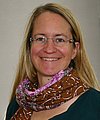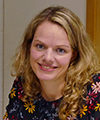10.02.2020 | Beate Kittl | News WSL
In the Swiss Federal Research Institute WSL’s Forest Resources and Management research unit, a field traditionally dominated by men until just a few years ago, three of the five research group leaders are female. In an interview conducted to mark the International Day of Women and Girls in Science, they shared their experiences with us.
Over your scientific careers, have you ever found yourselves in situations that a man would never experience?
Esther Thürig: Yes, definitely. For instance, when I was working at the Swiss Federal Office for the Environment (FOEN) after completing my PhD, I attended a meeting with experts from the forestry and wood industry and an older man said: “Ah, is the lady taking the minutes?”. Luckily, my boss immediately backed me up and made it clear that I was attending the meeting as an expert.
Janine Schweier: I’m the only woman on an expert committee and the – mostly older – men sometimes make a special point of asking me what I as a woman think about an issue. I’m sure they mean well, but I’m on the committee as an expert, so if I have something to say from my specialist viewpoint, I go ahead and say it.
Martina Hobi: There’s only one situation that comes to mind, when I was at a leadership seminar for federal employees. Sounding totally sure of himself, the guest speaker – a man aged over 50 – said that obviously nobody working part-time could occupy a leading role. It felt like a real snub, and I wonder if he only said that to me because I’m a woman.
Leaders working part-time
What’s it like being a woman working in a male-dominated field?
Hobi: We women in leadership positions are role models of sorts, and we’re always being asked to help out with gender-related topics – just like now. This is extra work that men probably don’t have to do.
Schweier: Yes, I have also been asked to speak at meetings of female doctoral students, for instance. But I hardly ever get asked any technical questions there. Most of the time, they just ask me about how to maintain a good work-life balance, and things like that.
Thürig: For a long time, I was the only woman at our research unit’s meetings. I really noticed the difference when another woman started attending. With the two of us, the meetings were suddenly 30% female, so we’d reached a kind of critical mass.
Schweier: It was really important for me to be able to work part-time because I have two children. Before I applied to the WSL, I did some investigating to see who was there already and whether any other people in leadership roles worked part-time. This really mattered to me.
What made you decide to go into this field of research?
Schweier: Even as a kid, I loved being in the forest. When I came to choose a career, forest sciences covered all the topics that interest me the most. So my mind was easily made up! When I was working on my doctoral thesis, women were very much in the minority, but there was a really friendly environment, regardless of their gender.
Thürig: I studied biology, and it took me a while to decide which field I’d go into. I worked on my thesis at the WSL. That’s how I got into forest research. When I was studying, and right up to when I wrote my PhD thesis, the proportion of women and men was roughly equal, but after that the number of women tailed off.
Hobi: I was always fascinated by the dynamics of primeval forests and by forest reserves. I studied environmental sciences, and the number of men and women was pretty balanced, more so than in other subject areas at the ETH. I’d actually never had any intention of doing a PhD, but when the WSL advertised a doctoral post in forest research in Ukraine, I thought that would be a great opportunity to go abroad and do something adventurous.
Schweier: That’s funny, because originally I hadn’t planned to do a doctorate either, but my boss urged me to do so: after all, I’d be doing the same work, even if I didn’t write a thesis. The encouragement and support I received from him made a real difference. And later on, when I had kids, the boss there said “just bring them with you to the office”. He also allowed me to do the work at times that are compatible with our family life.
Too young for a group leader?
What did it take for you to get to the leading post you occupy today?
Hobi: When the forest research vacancy at the WSL was advertised, I hesitated to apply because I thought I was too young to be a research group leader. I also really wanted to have a family. But I could also see myself leading a team, so I decided to seize the opportunity and figure out how to balance professional and family life later on. And I wasn’t the first female group leader in the unit either: Esther was already there.
Thürig: I wanted to find my own way in the research domain. When I was a scientific staff member at WSL after my diploma, I realised I’d need to be able to do more, so I undertook training in other fields too, like statistics.
Schweier: As in any leadership role, there’s a lot of hard work involved. But the gender dimension doesn’t just mean promoting women to top posts, it also means bolstering the entire concept by supporting part-time positions for men too.
Have you ever felt that you were only selected to meet some gender quota?
Hobi: I’ve never felt I was only appointed to a body because I’m a woman. It’s always been my expertise that counted. If committees need to have a set number of women on them, I think there’s a danger of women being made members who don’t know anything about the actual subject. This risk is especially high in fields that (still) don’t have a lot of women working in them.
Schweier: I’m sceptical about quotas. If there are enough women with the relevant expertise, then opportunities will emerge. These days, it’s totally normal for women to be invited to give prestigious keynote addresses at scientific conferences. They wouldn’t be asked to do it if they weren’t competent.
More empathy in the scientific community
Do you think you do anything differently from men in similar roles?
Hobi: Well, I do believe women bring more empathy to the scientific community. Personally, I set great store by having a positive working environment in my group, so my door is always open for my colleagues to talk about problems. Facts and results aren’t all that matters: how you obtain them is just as important!
Thürig: I try to make it possible for all my team members to do what they want. And I’m a big advocate of part-time work, especially for men. After all, if my husband didn’t work part-time too, I wouldn’t be able to do what I do.
Schweier: The same applies to me.
What do you think the future holds?
Schweier: If I’ve ever been treated differently to men because I’m a woman, then it’s always been a generational issue. Younger men today don’t see anything unusual about women holding down the same jobs as them.
Thürig: Even now, a lot of WSL research groups allow their staff to work part-time, including male staff. This not only facilitates a good work-life balance, it also makes the WSL an attractive employer. Moreover, I have the feeling that working part-time, but with a fairly high work ratio – say 70 or 80 per cent – makes you very efficient. I have to think carefully about what I can fit into my day, and I work more intensely.
Hobi: Diversity is definitely an asset when it comes to working together. Teams that contain a mix of people – not just in terms of gender, but also in terms of age and background – work better, because they approach issues from different perspectives.
What advice would you give other women in science?
Hobi: Grab any opportunity that comes your way, without first worrying too much about whether it’s going to work.
Schweier: Above all, don't lose courage after your doctorate and keep at it. This time was particularly challenging for me, as it is for many female scientists, because it is when you need to consider how to reconcile work and family planning.
Esther Thürig (left) is a biologist. She leads the Resource Analysis research group, which studies the current status and future development of forests and forest services.She has a son (10) and a daughter (9).
Janine Schweier studied forest sciences in Freiburg. Her research group, Sustainable Forestry, supports the forestry industry as it seeks to continue providing the full range of ecosystem services. She has two creche-aged sons.
Contact ¶
Links ¶
Copyright ¶
WSL und SLF stellen Bildmaterial zur Bebilderung von Presseartikeln im Zusammenhang mit dieser Medienmitteilung kostenfrei zur Verfügung. Eine Übernahme der Bilder in Bilddatenbanken und ein Verkauf der Bilder durch Dritte sind nicht gestattet.






